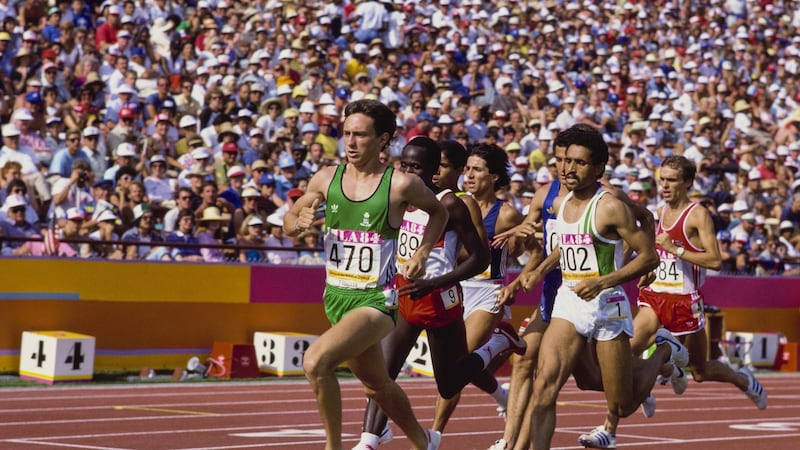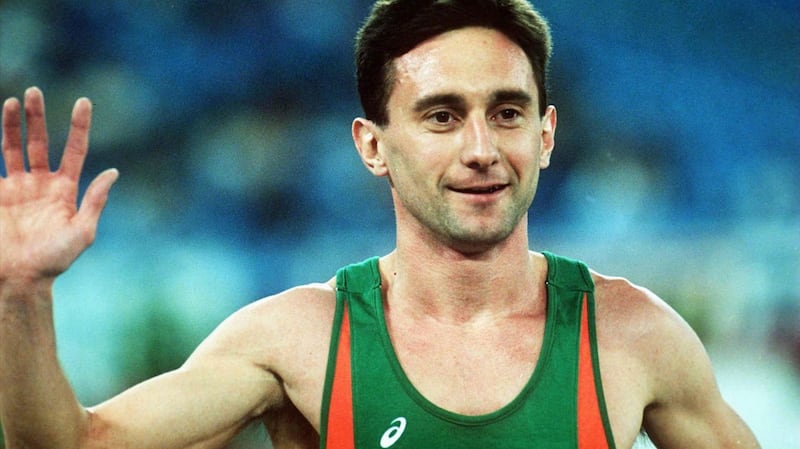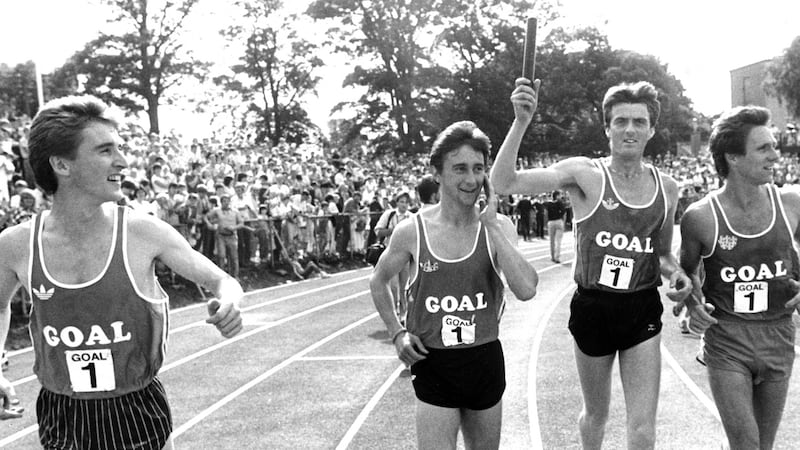In the winter of 1988 I'd just turned 18 years old and had been at Villanova University for about six months. Only I wasn't running much during that time, because of injury. The cross-country season had come and gone and now it looked like the indoor season would too.
At that stage of my career I'd never actually raced indoors before, my only experience of it coming from the TV back home in Cobh. Especially those images of Eamonn Coghlan, ripping up the boards at Madison Square Garden in New York, his Discover Ireland singlet first across the line at the Millrose Games.
Eamonn was the Chairman of the Boards, had won the famed Wanamaker Mile a record seven times, most recently in 1987, although he was beaten the year before that by Marcus O’Sullivan.
By then, Marcus was already a bit of a hero to me. He’d won the first of three World Indoor 1,500m titles in 1987, and he was from Cork, and he had a nice surname. When I first visited Villanova, around Easter of 1987, it was Marcus who showed me around beyond the campus, and convinced me this was the place to come, how the experience had stood to him.
It was a Friday afternoon, February 5th, 1988, when a group of us athletes from the Villanova track team decided to drive up to New York and catch the Millrose Games live and in person. Villanova was just under two hours from the City, so if we headed off after lunch we would get there in plenty time, and could drive back home again afterwards.
As a wide-eyed and still green 18-year-old, I jumped at the opportunity. Up to this point the only proper international athletics meeting I'd ever been to was the Cork City Sports, much closer to home. There was something properly mystical too about the Millrose Games at Madison Square Garden. The old wooden track, 11 laps to the mile, and just four lanes painted bright yellow and orange. A tight track, with tight bends, and a small select field.

On this night Marcus was down to run the Wanamaker Mile again, and we also had our Villanova team-mate Vicky Huber in the women's mile, plus two Villanova relay teams.
It was a nice distraction from being injured and unable to train and race, a way to feel connected to go along and support our team-mates and catch a glimpse of Marcus, our reigning World Indoor champion who lived just up the road from Villanova. Even though I’d met him a few times I was still in awe of him every time he raced.
To me Marcus was still in that category of people that you got nervous and shy around, or if you crossed paths in the park you’d get an extra spring in your step for the rest of the run. Marcus was out there running around just like I was. He was living the dream I was still dreaming about.
The Garden was packed to the rafters, and we were like the orchestra somewhere underneath the stage in the pits of a Broadway Show. We must have been given an extra athlete's pass, because I remember watching the athletes warming up beforehand on just concrete floors, like an indoor car park. The glitz and glamour was all out on the track, just like the Broadway stage.
We hurried out to watch the Villanova two-mile relay team win their race and run a lap around the track together after. How I wished I could be on the team and run on this stage. The entire place felt so full of energy, and what would it be like to run on the steep wooden boards? It didn’t make sense to wear spikes on such a hard surface, but the specially made rubber sole shoes and short spikes gave the perfect grip for athletes travelling at such speed on the tightest of bends.
Where we stood on the concrete floor, the track came right up to your chest and you could actually lean onto the top of it, right on the edge of lane four when the distance races were taking place.
People were banging the boards with their hands which added to the noise generated by the clatter of spikes on the wooden track, and what seemed more staccato than smooth running. Racing indoors, the athlete has to think and act so much more strategically than on an outdoor 400m track. It was all about balancing the expenditure of energy on the wooden boards that didn’t give a whole lot back to the runner.
This was the best spot to watch the races, where you could feel the track creaking as the runners ran past and over such a short lap. You didn’t have to wait long for the runners to be back around again.

Just before the Wanamaker mile, when all the warm-up and support races were complete, the lights were dimmed ahead of the main event, and a solo singer came out to sing the American national anthem.
The Garden went so silent you could hear a pin drop, then the seven athletes were called forward to the start line, the spotlight moving across each athlete as they were introduced to the audience. The stage was set, and we briefly stood back from the track. Once the start gun fired we were all back with hands on deck, getting as close as we could to the action.
The cheering and clapping moved in a wave around the track as the athletes ticked off each lap. Peter Elliott from England was the biggest challenge to Marcus. He would go on to win the Olympic 1,500m silver medal in Seoul later that year, although he had little experience of the tight indoor track, and was running as if he needed something to hold onto around the bends. Abdi Bile from Somalia, the World outdoor 1,500m champion, was also in there, and another Irish athlete and Villanova graduate, Gerry O'Reilly.
Eamonn was absent due to a back injury, and Marcus delivered the perfect tactical race, hitting the front with a lap and a half to go, ripping up the boards too and claiming his second Wanamaker Mile victory in 3:56.89. He would go on to win a total of five.
As Marcus ran around on his victory lap, I felt a share in the excitement, hands up looking for a high-five. It was one of the greatest highlights and inspiring moments of my first year at Villanova, definitely one of those moments where you get that feeling if you see it, you can be it. This is what I wanted to do.
All the stepping stones were laid out in front of me, one of my first-year class-mates had made the relay team, Michelle Bennett. I was sure I could do that too. Huber also finished third in the women's mile and would go on later that year to finish sixth in Seoul, as part of the US Olympic team.
And then there was Marcus. I had often seen him race on TV, knew from meeting him he was so normal, and here he was winning the Wanamaker Mile at the Millrose Games, the biggest star on the stage that night, beating the best athletes in the world and the crowd on their feet cheering and chanting his name.
It remains one of the clearest memories I have of any event I have watched as a spectator, the one event that showed me what was possible. I just had to work out how.

Thinking back now, how my athletics career overlapped with Marcus was quite extraordinary: I also shared my first Irish senior team with him, in 1987, along with Frank O’Mara, another hero of mine.
They were such great runners, but they also brought so much fun and laughter. I learned a lot off Marcus, including how to relax and enjoy what could so easily be a nervous and stressful time. When you are around people like that, and the encouragement they give each other, it gives even more reason to deliver a result in every race.
There were times too when Marcus and Frank would shake their heads and question what I was doing: one more run, the extra gym sessions, the drills and the strides? Before long they were joining me on a Sunday afternoon at the Teddington Cricket field.
Ten years later, in 1998, Marcus had just run his 100th sub-four minute mile at the Millrose Games and soon after made the long trip to Australia and New Zealand for a few races. There was a one-mile race scheduled for Melbourne, one more sub-four minute mile, just to make sure of the final tally: 101, just in case, typical of Marcus.
It was a few weeks before the 1998 World Cross-Country, in Morocco, and I was running through the Melbourne parks with Marcus, and typical of him again, I could tell he was nervous for me. He was there in 1996 in Atlanta, knew the repercussions of that. I was still chasing my dreams. I was in great shape and in good old Marcus fashion he was dishing out the advice on a run, calm and sensible.
Take it easy, you are as fit as can be . . . Just stop trying too hard . . . Relax and let the race come to you . . . You haven’t lost your ability to rise to the challenge.
It was up to me to decide my destiny, and it meant a lot that my childhood and real life hero still believed in me.
[ Click here to watch the 1988 Wanamaker Mile.Opens in new window ]
Share your favourite sporting moment to be in with the chance to win a selection of sports vouchers. Entries should be no more than 400 words and can be sent to sportingmoment@irishtimes.com. The three overall winners will be published on Saturday, April 18th.












